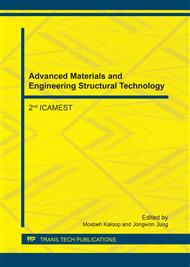p.296
p.302
p.308
p.313
p.318
p.324
p.330
p.336
p.341
Sustainable Architecture with Bamboo Columns Technology
Abstract:
Compositions with different pipe segments for constructing structural columns were investigated. In this article there is shown a column type composed of five parallel bamboo bars, connected by screws 16 mm and 13 mm in diameter. Compression tests instrumented with displacement transducers are associated with numerical modeling analysis to describe the column load capacity, from the general criteria of dimensioning. The chosen Bamboos are from the species Phyllostachys pubescens due to its favorable characteristics to produce structures and their common use in China, Brazil and other countries of temperate zones. In this proposal, the load capacity is considerably increased and lateral displacements are insignificant compared to the bamboo tested separately. More usual columns 3 and 4 meters long were modeled and presented the load limits of use for these types of structures. Other dimensions of columns can be calculated by the same system, presenting great design opportunities in the construction of the architecture and built spaces. This article shows a great advantage in using columns with bamboo bars compared to other materials used in the architecture, with guarantee and good indexes of security.
Info:
Periodical:
Pages:
318-323
Citation:
Online since:
April 2017
Keywords:
Price:
Сopyright:
© 2017 Trans Tech Publications Ltd. All Rights Reserved
Share:
Citation:



